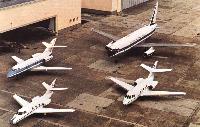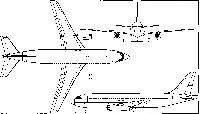
Описание
Страна : Франция
Год : 1971
Ближнемагистральный авиалайнер с экипажем из двух человек
Dassault Mercure
Первые успешные продажи самолетов семейства Mystere/Falcon 20 побудили "Dassault" инвестировать в разработку нового ближнемагистрального авиалайнера того же класса, что и Boeing Model 737, объемы продаж которого были беспрецедентными.
Облик Mercure был близок к Model 737 - низкоплан с герметичным фюзеляжем круглого сечения, рассчитанный на перевозку 120-150 пассажиров, а в экономической конфигурации - до 162 пассажиров. Хвостовое оперение традиционного типа, шасси - трехопорное, с двумя колесами на всех стойках. Подобно Model 737, силовая установка Mercure состояла из двух турбовентиляторных двигателей Pratt & Whitney JT8D серии Dash-15 (эти двигатели были возможны как опцион на ранних Model 737).
Стоимость программы оказалась очень большой, поэтому проект субсидировало правительство Франции. Финансовый риск разделился следующим образом: 56% - правительство, 14% - компания "Dassault", остальное - другие фирмы.
Первый прототип выполнил свой первый полет 28 мая 1971 года с регистрацией F-WTCC, три последних литеры отражали назначение - "Transport Court-Courrier", т.е. "транспортный ближнемагистральный". На первом прототипе стояли два двигателя JT8D-11 тягой по 66,72 кН, а второй прототип, выполнивший первый полет 7 сентября 1972 года, получил двигатели JT8D-15. Решение о запуске в серию предстояло принять только после получения твердых заказов на 50 самолетов, но столь большой портфель заказов собрать не удалось, и серийное производство начали после получения заказов на десять Mercure 100, приобретенных 29 января 1972 года внутренним французским перевозчиком "Air Inter". Первый из десяти самолетов компания получила 16 мая 1974 года. "Air Inter" так и осталась единственным эксплуатантом Mercure, получая ежегодные субсидии от французского правительства по причине чрезвычайно высокой стоимости запчастей - следствие быстрого сворачивания серийного производства.
ТАКТИКО-ТЕХНИЧЕСКИЕ ХАРАКТЕРИСТИКИ
Dassault Mercure
Тип: ближнемагистральный авиалайнер с экипажем из двух человек
Силовая установка: два турбовентиляторных двигателя Pratt & Whitney JT8D-15 тягой по 66,72 кН
Летные характеристики: максимальная крейсерская скорость на высоте 6095 м - 925 км/ч; начальная скороподъемность 1006 м/мин; дальность с максимальной полезной нагрузкой 756 км
Масса: пустого 31 800 кг; максимальная взлетная 56500 кг
Размеры: размах крыла 30,56 м; длина 34,84 м; высота 11,37 м; площадь крыла 116,00 м!
Полезная нагрузка: до 162 пассажиров в контексте массы полезной нагрузки 16 200 кг
- Описание
Фотографии
-
Air Enthusiast 1972-03 / ??? - Mercure: a Short-Haul Gamble
Регистрационный номер: F-WTCC [4] The first prototype Mercure will be joined by a second aircraft in mid-1972, incorporating all the modifications found to be necessary in the course of test flying since May 1971.
-
Мировая Авиация 58
Регистрационный номер: F-WTCC [4] 28 мая 1971г.: поднялся в воздух первый из двух прототипов (F-WTCC) среднемагистрального двухдвигательного пассажирского самолета Dassault Mercure.
-
Aviation Historian 38 / K.Hayward - Airbus Industrie Britain's Return
Регистрационный номер: F-BTTE An early foray into international collaboration on airliners, the twin-engined Dassault Mercure had construction input from Fiat in Italy, CASA in Spain, SABCA in Belgium and Emmen in Switzerland. The prototype made its first flight in May 1971, but it was not a success, a total of only 12 being built.
-
Мировая Авиация 101
В силу высоких эксплуатационных расходов и небольшой дальности полета Mercure не смог составить конкуренцию Boeing 737.
-
Air Enthusiast 1972-03 / ??? - Mercure: a Short-Haul Gamble
The full range of Dassault commercial aircraft comprising, in addition to the Mercure, the Falcon 20 (extreme right), the Falcon 10 (left foreground) and the Falcon 20T, a full-scale mock-up of which is shown upper left.
Другие самолёты на фотографии: Dassault Falcon 10 - Франция - 1970Dassault Falcon 20 / 30 - Франция - 1963
-
Jane's All the World Aircraft 1972 / 01 - Aircraft
Photograph of the Dassault Mercure large-capacity transport
-
История Авиации 2001-05 / С.Корж, Г.Петров - Plasticart: модели и самолеты /Ностальгия/ (5)
Первый опытный самолет "Меркюр" в раннем облике.
-
Air Enthusiast 1972-03 / ??? - Mercure: a Short-Haul Gamble
The Mercure 01 at take-off.
-
Air Enthusiast 1971-08 / Airscene
Flight testing of the Dassault Mercure short-haul twin-engined transport began on 28 May 1971, and the aircraft was demonstrated at the Paris Air Show a week later. Powered by Pratt & Whitney JT8D-7 engines, this prototype will be followed by a second with the definitive JT8D-15 engines and higher operating weights.
-
Air Enthusiast 1972-03 / ??? - Mercure: a Short-Haul Gamble
Регистрационный номер: F-WTCC [4] The Mercure 01 on its first flight. Since this picture was taken, dihedral has been introduced on the tailplane and other modifications have been made.
-
Jane's All the World Aircraft 1972 / 01 - Aircraft
Регистрационный номер: F-WTCC [4] First prototype Dassault Mercure short-range transport aircraft (two 15,000 lb st Pratt & Whitney JT8D-11 turbofan engines)
-
История Авиации 2001-05 / С.Корж, Г.Петров - Plasticart: модели и самолеты /Ностальгия/ (5)
Второй опытный "Меркюр" в полете.
-
Jane's All the World Aircraft 1974 / 01 - Aircraft
The first and second (nearest camera) prototypes of the Dassault Mercure short-haul large-capacity transport
-
Jane's All the World Aircraft 1980 / Encyclopedia of Aviation - 2. World Directory of Airlines
Air Inter Dassault Mercure.
-
Jane's All the World Aircraft 1976 / 01 - Aircraft
Регистрационный номер: F-BTTA Dassault Mercure short-haul large-capacity transport in the insignia of Air Inter
-
История Авиации 2001-05 / С.Корж, Г.Петров - Plasticart: модели и самолеты /Ностальгия/ (5)
Второй опытный "Меркюр" на авиасалоне "Ле Бурже-73" в окраске "Эйр Интер".
-
Jane's All the World Aircraft 1980 / Encyclopedia of Aviation - Aircraft A-Z - v3
Dassault Mercure production line.
-
Air Enthusiast 1972-03 / ??? - Mercure: a Short-Haul Gamble
The Mercure flight deck is laid out to permit two-crew operation, with radio and navaids grouped in the overhead panel.
-
История Авиации 2001-05 / С.Корж, Г.Петров - Plasticart: модели и самолеты /Ностальгия/ (5)
Регистрационный номер: F-WTMD -
Air Pictorial 1958-03
An artist's impression of the Dassault Mediterranee, a ten-seat, twin-jet executive transport, to be powered by two Dassault R-30 turbojets. Prototype, now under construction, is expected to fly some time this year.
-
Air Enthusiast 1972-03 / ??? - Mercure: a Short-Haul Gamble
Регистрационный номер: F-BILT Two of the projects studied by Dassault before embarking on the Mercure were (upper) the Mediterranee and (lower) the Mystere 30, which was later renamed Mercure.
-
Air Pictorial 1969-06 / J.Stevens - France's Aircraft Industry
An impression of the Dassault Mercure 116/155-passenger short-haul airliner which is scheduled to fly in 1971 and enter service in late 1972
-
Air Pictorial 1977-06 / M.Hardy - France's Aircraft Industry
Artist's impression of the ASMR airliner project. Developed from the Dassault Mercure 200 in co-operation with McDonnell Douglas, it received a lukewarm response from U.S. airlines
-
Jane's All the World Aircraft 1966 / 02 - Aircraft
Dassault Sud-Aviation Mercure twin-jet short-haul transport
-
Jane's All the World Aircraft 1972 / 01 - Aircraft
Three-view drawing of the Dassault Mercure large-capacity transport
-
Jane's All the World Aircraft 1974 / 01 - Aircraft
Developed version of the Mercure with JT8D-17 engines and slightly increased span and length
-
Jane's All the World Aircraft 1975 / 01 - Aircraft
Dassault Mercure twin-turbofan short-range large-capacity transport
-
Air International 1985-06 / ??? - A320: Third Generation Airbus
While European governments struggled during the mid-'seventies to agree a format within which their respective aircraft manufacturers could work together on large civil aircraft, several companies actively promoted derivatives of existing designs, such as the Dassault-Breguet Mercure 200
- Фотографии






























